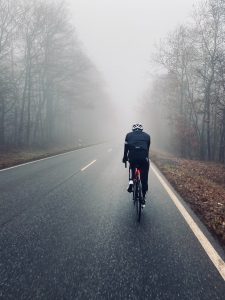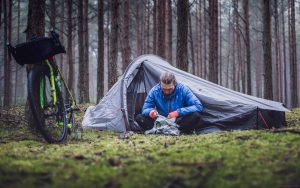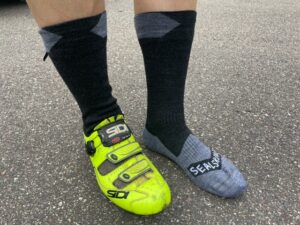Rain is going to happen – that doesn’t always mean you have to stay indoors and skip your ride.
And what do you do if you’re bike camping or in the middle of on a long tour and it starts to rain? Following the right steps and tips can make all the difference when it comes to staying safe and still having a good ride, even when the rain is coming down hard. Remember these 6 tips whether you get caught out in the sudden weather or you make a plan to head out into the rain.
The answer ultimately is affected by the type of bike you are riding — for example, gravel bikes have different rain dynamics than road bikes, and mountain bikes or fat bikes are different altogether.
Tip #1: Slow Down!

As with driving, one of the best things you can do when cycling in the rain is to slow down! Slower riding helps you see hazards in the way, including larger puddles or potholes that could cause you to injure yourself or damage your bike. When you hit an extended wet area, you can lose traction on slippery roads or terrain. Heavy rain also has a habit of obscuring obstacles.
You will also be thankful for slowing down when you come to a stop, or an intersection. While bike tires are surprisingly good while moving on a wet surface, they are not good when you have to stop quickly on a wet surface. Allow extra time so you can really bump the brakes and come to a more gradual stop.
Slowing down, even just a little bit, will help you identify larger puddles, potholes, and obstacles before you run into them.
Tip #2: Use the Right Gear
If you’re thinking about heading out in the rain or wet weather is on the forecast for the day ahead, it can help to have the right gear ready to go. There are a few different things you can use to increase your comfort, safety, and overall ride.
Shoe Covers
When riding a bike, whether it’s raining or you hit a single puddle, your shoes are going to get wet. As it seeps in, you’ll soon be dealing with wet socks and wet feet, which can lead to a very uncomfortable and cold ride.
Instead, you can opt for waterproof overshoes. Not only will they keep the water out, they will keep your feet warm.
Waterproof Bike Socks
You may also want to go for waterproof socks if it’s particularly nasty outside, because it is really soaking socks that are uncomfortable vs. wet shoes. I like the Sealskinz socks (here on Amazon) for these situations. I’ve used them during bad weather gravel bike races, and they work really well.
The socks are perhaps not as breathable as a lightweight sock, so in hot weather you might want to think twice as they might cause sweating. But they are not that much heavier than normal socks, and in wet conditions I don’t think they can be beat.
Waterproof Clothes
In addition to shoe covers, there are plenty of waterproof clothes you can opt for to make your cycle more enjoyable. Waterproof cycling or running jackets, when designed correctly, will stay breathable while keeping rain out, even if you’re going hard or heading out for a long trip. Waterproof tights can do the same job. The good news is that most cycling shorts are already designed in a way that won’t get saturated with water — the shorts will be the least of your worries. It is really about your feet, torso, hands, and head.
Cyclists should also consider adding waterproof gloves to their gear bag. Cold hands can make it difficult to concentrate, and all that water is going to make them slippery. Waterproof bike gloves can help ensure you keep your grip on your handlebars and aren’t thinking too much about the cold.
And, of course, you want to keep your head dry. A helmet will do part of the work for you, but when that water drips in, it can get a bit frustrating. Cycling caps, especially waterproof ones, can be an excellent addition to your trip and are worn underneath your helmet.
Glasses
Don’t forget about protecting those eyes. Now that you’re keeping the water off your body, it’s time to think about keeping that water out of your eyes. Cycling glasses are an absolute must. They’ll shield your eyes from even pelting rain and keep any mud, dirt, or dust out, too.
Keep in mind that the cycling glasses will need to be wiped often to give you a clear field-of-vision, and that because it is probably lower-light when raining, you may want to consider un-tinted or clear glasses. The goal of the glasses in this situation is more about safety than it is about sun protection.
Lights
You probably have lights already on hand if you’re going for early morning or late night rides, but are you bringing them along on rainy days? Yes, big time.
It’s generally a good idea to have your headlights on in the rain – same goes with cycling. Dark clouds, heavy rain, and low light make it difficult for you to see, and, if you’re on the road or trail, for drivers and other cyclists to see you. Small LED cycling lights that blink can be attached to your front and rear to make sure you’re more noticeable to others.
You are basically trying to do everything you can to be more visible to others.
Mudguards
Mudguards are another great addition to your bike if you don’t have them already. Even if you wait for the rain to pass, the roads and trails will still be full of water and mud. As you ride, that water and dirt is going to kick up. A mudflap or mudguard can keep the water off your back, legs, and feet during and after wet weather.
Mudguards are not just for mountain bikes. I see lots of gravel and road cyclists put temporary mudguards on for a wet weather ride.
If you ride with a group, your partners will thank you for the mudguards, too, because they will get less water and mud in their face.
Tip #3: Choose the Right Bike and Tires

Did you know there is a big difference between a road bike and a mountain bike in the rain? It mostly comes down to the tires – road bike tires tend to be more slick and require you to ride at higher tire pressure, which actually means they keep a consistent contact with the road and get a better grip, even in wet conditions.
That’s right — those skinny road bike tires with seemingly no tread actually do pretty well on a wet road. The “pointiness” of the tire ensures you keep more contact with the ground, and the high pressure of the tire has a way of pushing water out of the way. With that sad, painted or wooden wet surfaces are very bad, and you should try to avoid them or go very slow over them. Think wooden bridges covering a stream — they are going to be slippery when wet and VERY slippery if they have any moss on them which is pretty common.
When it comes to your mountain bike, or if your road bike tires aren’t slick, you may want to opt for a different type of tire. Tubeless tires or tires with a puncture belt will help you avoid a flat even if you hit a pothole or debris.
The thing you want to avoid on a bike is the dreaded hydroplane, and as long as you are riding with relatively high PSI, you should be able to maintain contact with the pavement and avoid the hydroplane.
Still, having the right tire is still no match for a heavy downpour. Even if you are happy with your tires, refer back to rule #1 — slow down!
Tip #4: Get Your Bike Ready
Too much rain can actually be detrimental to your bike. You’ll need a few things to make sure it can handle the wet weather.
Lube
Bike lubes come in different types and styles. Wet lube is actually better than dry lube when it comes to rain and your bike. It will help keep your pedaling smooth and your chain water-resistant. And if you live in a place where they salt the roads during wintertime, you’ll give your chain a bit of extra protection.
Water-resistant Grease
Are you greasing your key bearings from the headset to the hubs? Adding grease, especially water-resistant options, will help keep the rain out as well as dirt and dust.
A Fix a Flat Kit
Even if you take the precautions listed above when it comes to your tires, you can still get a flat. Always have tools on hand so you can quickly get back on the road.
And Take Care of it After the Ride!
You don’t only want to prep your bike prior to your rainy ride – you’ll want to care for it once you park it for the night, too. Your bike should be washed and dried before a fresh coat of bike lube is applied. You should also take this time to make sure it doesn’t have any damage.
If you encountered mud on the ride, it opens up a whole additional set of clean-up tasks. I’ve had rides where the bottom bracket gets so gummed-up with grime that it needs a cleaning and greasing. And your chain needs lots of TLC after a mud ride — probably multiple cleanings with a soft brush and soapy waters, or even a soak. This is where it is nice to have bike tools at home to do some of this basic cleanup.
Ideally, dry the bike in a heated or drier environment, like in a garage or inside your entryway (if the others living with you are agreeable to it).
Tip #5: Keep an Eye Out for Moving Water
As with driving, you should always keep an eye out for moving water. Do not enter it, especially if you can’t see the road or trail underneath it. Currents can be extremely (and unbelievably) strong in flood waters and it doesn’t take a lot to knock you over. Do not try to cross any flooded areas.
There is no shame in getting off your bike and walking it around the hazard. You might be thankful you did. And if the temps are close to freezing, then the moving water is really a problem as it could create patches of ice. You can coast over some ice if you are lucky, but it is a bad thing to try to do.
Tip #6: Know When to Turn Back

Although riding in the rain can be a ton of fun or you just really want to complete your session, that doesn’t mean pushing through the worst of conditions. Keeping an eye on the forecast before you head out can help ensure you’re not heading into serious weather like severe thunderstorms, flooding, or even possibly tornadoes.
If you get caught outside and the weather is taking a turn for the worse, turn back or seek shelter immediately. Know your limits and know the dangers of staying outside in inclement weather.
There is no shame in calling it, heading indoors, and putting your bike on the bike trainer for a good spin-and-sweat. We do it all the time.
Rain doesn’t necessarily mean you have to turn in from your cycle or skip it all together. However, it does mean you have to be prepared. This means having the right gear, for you and your bike, while also knowing how to stay safe around water, potholes, and floods. These tips will help you stay safe whether you’re caught out in a drizzle or a downpour.








